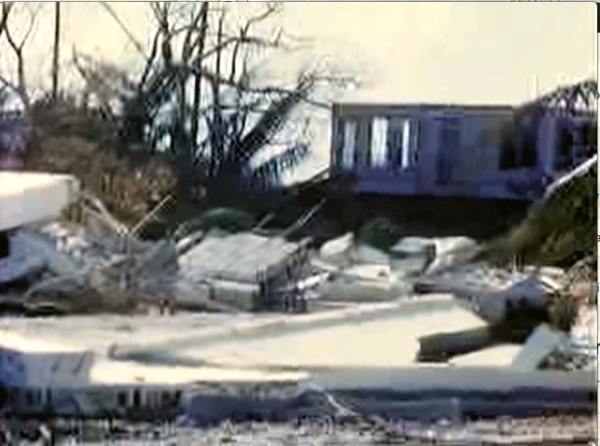
On the morning of September 10, 1960, Hurricane Donna came roaring through the Florida Keys as it began its rampage up the east coast of the United States. Four days later it had affected every state along the Eastern Seaboard leaving an astonishing trail of destruction.
Donna began as a Cape Verde storm, forming in the eastern Atlantic on August 30th. Within two days it reached hurricane status and continued on a steady west-northwest track through the deep tropics. Donna underwent a period of rapid intensification and peaked on September 4th with maximum sustained winds of 160 mph (260 km/hr) as it approached the Leeward Islands. The first US Weather Bureau (USWB) research flight into the storm occurred as it passed over Barbuda, finding its intensity had decreased slightly. Gales, high tides, and heavy rains affected the Virgin Islands and Puerto Rico as Donna passed to their north. The mountains of Puerto Rico recorded over 15″ of precipitation in spots. The USWB aircraft, examining Donna at this time, found its maximum sustained wind diminished to 125 mph (205 km/hr).
Next, the major hurricane set its sights on the Turks and Caicos Islands as it swung to a westerly course and restrengthened. It raked the southern Bahamas with a 150 mph (240 km/hr) gust blowing away an anemometer on Ragged Key. The research planes, now operating out of Miami, found the storm had reached Category-4 status again. Many buildings on the smaller Bahama islands were blown away, and the infrastructure badly damaged. It would take years to rebuild.

Donna’s eye passed south of Andros Island and the hurricane turned northwest, heading for south Florida. The research aircraft had to evacuate from Miami International Airport and headed for Nassau, Bahamas, but continued to fly research missions as the storm ravaged the middle Florida Keys near Marathon. Its maximum sustained winds were now at 140 mph (230 km/hr) and great destruction was done to homes and commercial buildings. A team from the National Hurricane Research Laboratory (NHRL) traveled down to the Keys to document the damage. By now, the hurricane was within range of the weather radars in Miami, both the University of Miami’s unit and the USWB’s newly-installed WSR-57. A great deal of scientific information was gathered from this major hurricane passing so close to these state-of-the-art instruments.
The eye of Donna ran along the west coast of Florida, eventually crossing inland north of Fort Myers. It passed over the peninsula and exited at Daytona, still a powerful hurricane. There were no more research flights into Donna from this point on, as its center would remain too close to land. It moved along offshore of Georgia and South Carolina, but still bringing heavy rain and high surf to their coasts. It came ashore in North Carolina as a Catagory-2 hurricane, and ran northeastward passing briefly over water before making a final landfall on Long Island, NY. By now, Donna had gotten caught up in a cold front and moved rapidly into New England and the Canadian Maritimes, transitioning into a strong extratropical low. By September 14th it became indistinguishable from the rest of the front over the Labrador Sea.
Donna’s death toll was over 350 people and during its life caused US$900 million in damage from Africa, through the Caribbean, and all along the east coast of the United States and Canada.
Some research papers written by HRD/NHRL scientists involving Hurricane Donna:
Dunion, J. P., C. W. Landsea, S. H. Houston, and M. D. Powell, 2003: A Reanalysis of the Surface Winds for Hurricane Donna of 1960. Mon. Wea. Rev., 131, 1992–2011.
Kaplan, J., and M. DeMaria, 2001: On the decay of tropical cyclone winds after landfall in the New England area. J. Appl. Meteor., 40, 280-286.
Pielke, R. A. Jr., and C. W. Landsea, 1998: Normalized hurricane damages in the United States: 1925-95. Wea. Forecast., 13, 621-631.
Sanders, F., and R. W. Burpee, 1968: Experiments in barotropic hurricane track forecasting. J. Appl. Meteor., 7, 313-323.
Miller, B. I., 1964: A study of the filling of Hurricane Donna (1960) over land. Mon. Wea. Rev., 92, 389-406.